Living in the UK, we expect a lot from our waterproof shell jackets. They get well and truly put through their paces all year round. Regular maintenance will keep your jacket performing and breathing at its best, making your time outdoors more enjoyable. If your shell jacket isn’t beading water as well as it used to, smells a bit pongy or hasn’t seen a washing machine in a very long time. Then it’s time to wash your waterproof jacket and reapply the DWR (durable water repellent). Not familiar with the process? Don’t worry, it’s not as daunting as it sounds.
In this blog, you’ll learn why you need to wash your waterproof jacket, how to do it and the benefits of regularly maintaining your kit. Including an easy step-by-step guide on washing and reapplying the DWR to your hardshell clothing.
Can I wash my waterproof jacket in the washing machine?
We understand some people are hesitant to wash their waterproof clothing as their quite expensive pieces of kit. But, if you follow the care label and our handy step-by-step guide, you won’t ruin it! In fact, keeping your jacket clean and well-maintained will enhance its performance and increase its overall life span. Which, in turn, is better for the environment and your wallet!
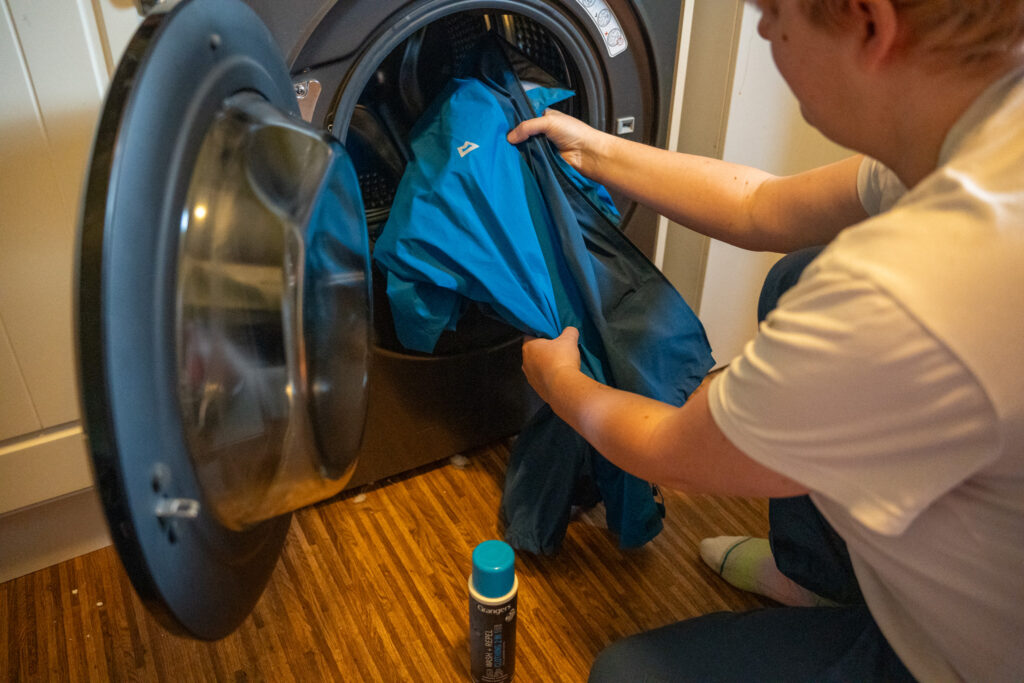
Why Do You Need to Wash Your Waterproof Jacket?
Like all items of clothing, over time, your waterproof jacket will no doubt get dirty and begin to smell with frequent use. Whether that’s from falling over in the mud, sweating when you’re working hard or rubbing up against grubby rocks and trees on the trail. This build-up of dirt, sweat and oils from your skin can lessen your jacket’s performance, breathability and water repellency.
How does my waterproof jacket work?
Most waterproof jackets have 3 layers. A durable outer face fabric, a waterproof membrane sandwiched in the middle and a protective lining. This construction shields the waterproof membrane from the rigor of frequent use because it’s a lot less durable. It needs to be kept clean to keep performing well and stay in good condition for many years to come. The outer face fabric is treated with a DWR to repel water, dirt and oils that could hinder or damage the membrane.
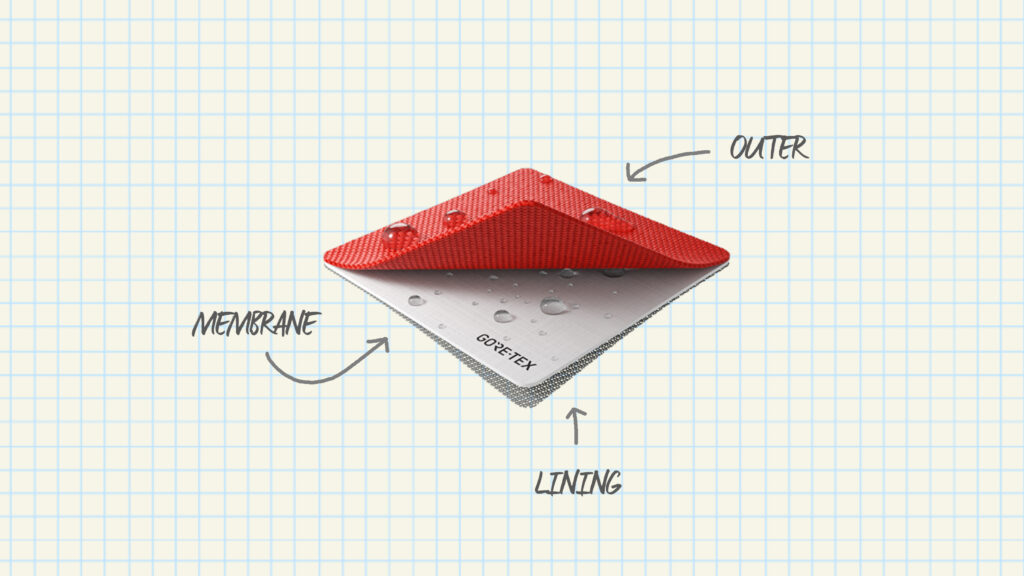
The consequences of not washing your waterproof jacket?
As you sweat, tiny particles of skin, oil, moisturising lotion, sunscreen, perfume, etc, transfer from your skin onto the clothes that you are wearing. Sounds gross, right? If your jacket isn’t washed regularly, this builds up over time. It not only causes your jacket to smell, but it also blocks the waterproof membrane, reducing its breathability. Certain oils, moisturisers and chemicals found in beauty and skincare products can even cause permanent damage! Which is not what you want to happen to your favourite shell jacket!
Why is your waterproof jacket not working as well as it used to?
This hindered breathability can make your jacket feel cold, clammy, uncomfortable and like it’s leaking. This isn’t usually the case; it’s not water getting in, it’s water vapour that can’t escape. This unpleasant build-up of moisture can quickly sap the joy out of your adventure and lead you to believe that your jacket is to blame. It’s a sure sign that it needs a good wash and reapply of the DWR.
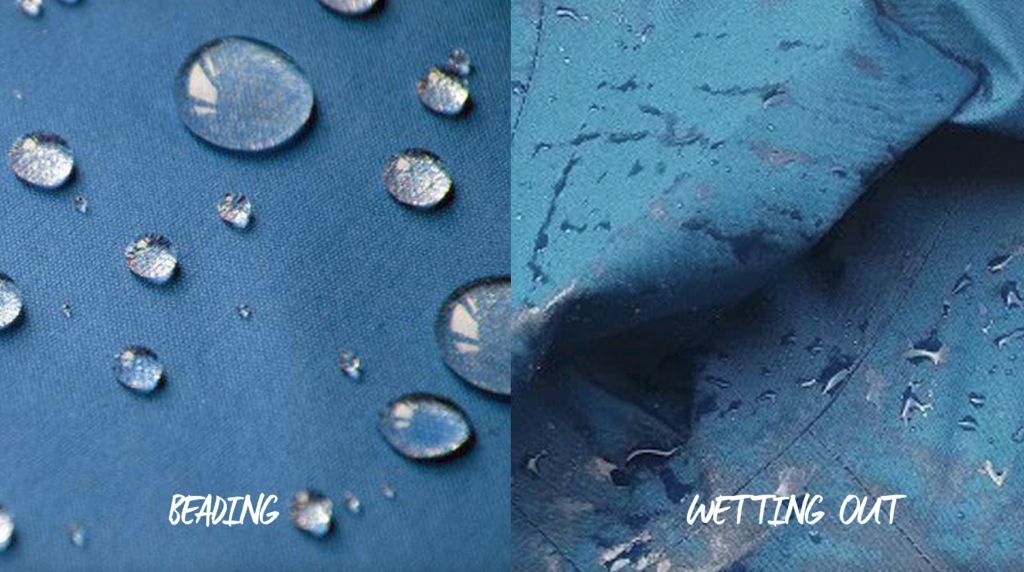
How Often Should You Wash Your Waterproof Jacket?
Unfortunately, we can’t recommend a specific number. It varies from user to user, depending on how often you wear the jacket or what you use it for. A general rule is whenever it looks/feels dirty, is a bit smelly, or water no longer beads off the outer fabric. You’ll notice that instead, the water sits on the fabric surface, soaking in. Generally speaking, the beading will go first on high-wear areas such as the shoulders and waist, where a rucksack will rub over time and across the cuffs. These areas are the best indicators that your jacket needs some TLC.
What is the best detergent for washing your waterproof jacket?
We recommend using a technical detergent like the Grangers or Nikwax products to wash and reapply the DWR. Some of these products require two stages to wash and then re-apply the DWR. Such as the Nikwax Tech Wash and TX Direct. While others, like the Grangers 2 in 1 Wash and Repel, do it all in one cycle to save water, energy and time.
What is the difference between Nikwax and Grangers?
Both brands offer separate wash and repel products, which are equally as effective. Some customers who don’t have a tumble dryer swear by using separate products across two cycles for the best result. Whereas others experience the same performance from both options. As with many things in the outdoor industry, the choice is down to personal preference.
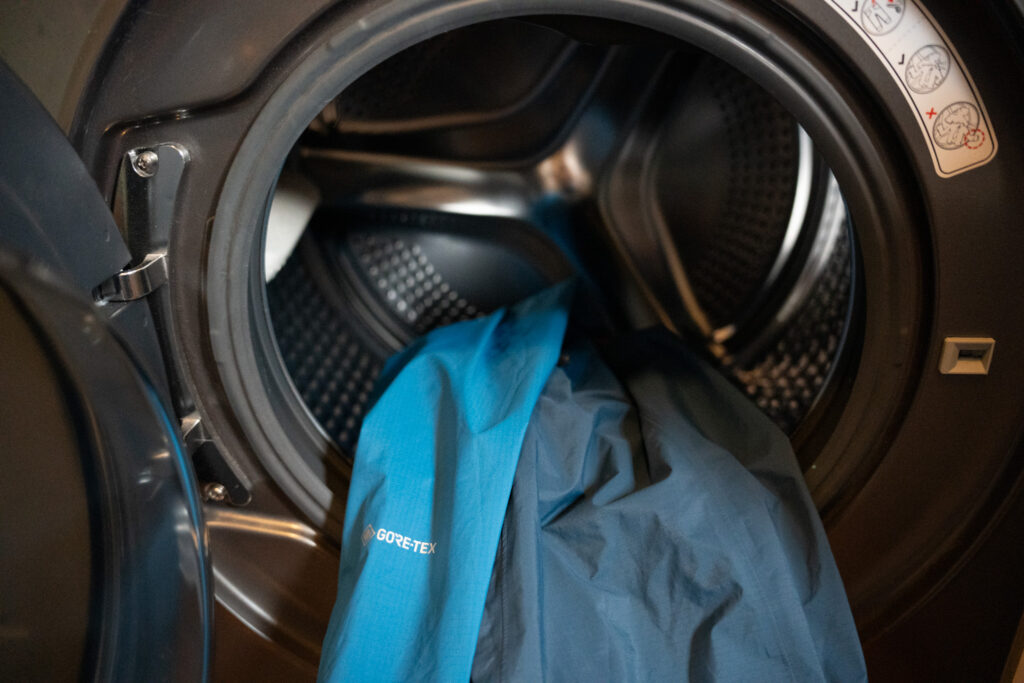
How To Wash Your Waterproof Jacket
1. Check the care label
Firstly, read your jacket’s care label instructions before you go anywhere near your washing machine. They’re usually found either on the inside hem of the jacket or tucked away inside one of the pockets. You’ll need to find out what temperature wash it requires and whether or not it can be tumble-dried.
2. Prepare your washing machine
Ensure your washing machine is clean and free from dirt, debris or detergent from previous washes by running a quick rinse cycle. Pay special attention to the detergent draw. If it looks a bit grubby, take it out and give it a good wash to remove any leftover regular detergent or fabric softeners that may harm the jacket’s coatings.
3. How dirty is your hardshell jacket?
The next step is to get your jacket ready for washing by assessing how dirty it is. Are there any obvious stains that need to be addressed? Is it muddy? If so, try to remove as much of it as possible when the mud is dry. For stains, we recommend pre-treating them with some of the Grangers or Nikwax detergent you’re about to use.
4. Get your jacket ready to wash
Make sure all the pockets are empty before washing your waterproof jacket. Do up all of the jacket’s zips, release the hood/hem drawcords and loosen any Velcro cuffs. Make sure the Velcro is closed for the washing cycle, so it doesn’t catch on any part of the jacket.
5. Time to wash your waterproof jacket
Pop your jacket into the washing machine and dose with your chosen detergent as per the bottle’s instructions. Select a synthetic or delicate cycle on either 30 or 40 degrees, depending on your jacket’s care instructions. Then let the washing machine work its magic.
6. How to reapply your jackets DWR
If you’ve used the Grangers 2 in 1 Wash and Repel to wash your waterproof jacket, you can go ahead and skip this step. If you’ve used the Nikwax Tech Wash or the Grangers Performance Wash to clean your jacket, once the cycle has finished, you’ll have to run it again with the corresponding repel treatment to reapply the DWR.
7. How to activate the DWR
Now you’ve washed your waterproof jacket; it’s time to dry it. If the jacket’s care instructions allow, tumble dry it. If you don’t have access to a tumble dryer or your jacket is not suitable to be tumble dried, iron the jacket on medium heat to dry it. Use a clean tea towel as a barrier between the iron and the jacket to protect it. Both methods of heat will activate the new DWR coating. Be careful not to use to much heat that you could risk damaging your jacket.
8. The final test
Once thoroughly dried, your jacket is good to go! You can pop the jacket’s sleeve under a running tap and you’ll see the water beading or moving off the jacket instead of soaking into the outer face fabric as before. It’s quite satisfying!
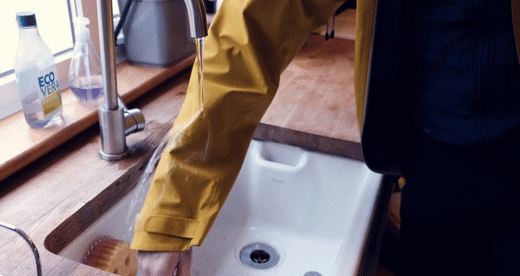
Once complete, you’ll have a fresh, clean-smelling waterproof jacket that’s had its DWR fully rejuvenated and is ready for more adventures out on the hill. Its improved performance after washing shows how fundamental regular care and maintenance is to keep your jacket performing at its best and breathing to its maximu
Why does my new waterproof jacket need washing more than my old one?
Due to recent changes in the legislation regarding the use of PFCs. Going forward, waterproof technologies like Gore-Tex® and other proprietary membranes will continue to develop into more environmentally friendly options. These new membranes will require slightly more care to keep them performing well. One of the main waterproof technologies which is currently changing is Gore-Tex®. For more information about what this change means and why it’s happening, read our blog here.
As always, if you have any questions or need further advice about any of our products, you can visit us in-store at our Hereford Service Centre. or speak with our friendly customer service team via telephone (01432 263 335) or email ([email protected]) or contact us via our social media channels linked below.

Leave a Reply